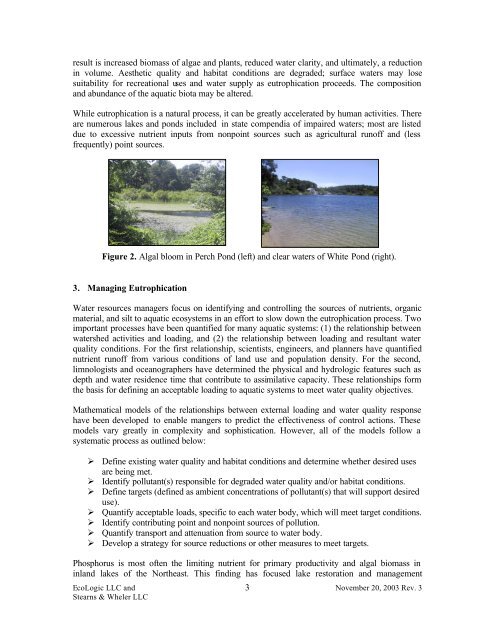Action Plan for the Town of Chatham Ponds
rev 3a report.pdf - Town to Chatham
rev 3a report.pdf - Town to Chatham
You also want an ePaper? Increase the reach of your titles
YUMPU automatically turns print PDFs into web optimized ePapers that Google loves.
esult is increased biomass <strong>of</strong> algae and plants, reduced water clarity, and ultimately, a reduction<br />
in volume. Aes<strong>the</strong>tic quality and habitat conditions are degraded; surface waters may lose<br />
suitability <strong>for</strong> recreational uses and water supply as eutrophication proceeds. The composition<br />
and abundance <strong>of</strong> <strong>the</strong> aquatic biota may be altered.<br />
While eutrophication is a natural process, it can be greatly accelerated by human activities. There<br />
are numerous lakes and ponds included in state compendia <strong>of</strong> impaired waters; most are listed<br />
due to excessive nutrient inputs from nonpoint sources such as agricultural run<strong>of</strong>f and (less<br />
frequently) point sources.<br />
Figure 2. Algal bloom in Perch Pond (left) and clear waters <strong>of</strong> White Pond (right).<br />
3. Managing Eutrophication<br />
Water resources managers focus on identifying and controlling <strong>the</strong> sources <strong>of</strong> nutrients, organic<br />
material, and silt to aquatic ecosystems in an ef<strong>for</strong>t to slow down <strong>the</strong> eutrophication process. Two<br />
important processes have been quantified <strong>for</strong> many aquatic systems: (1) <strong>the</strong> relationship between<br />
watershed activities and loading, and (2) <strong>the</strong> relationship between loading and resultant water<br />
quality conditions. For <strong>the</strong> first relationship, scientists, engineers, and planners have quantified<br />
nutrient run<strong>of</strong>f from various conditions <strong>of</strong> land use and population density. For <strong>the</strong> second,<br />
limnologists and oceanographers have determined <strong>the</strong> physical and hydrologic features such as<br />
depth and water residence time that contribute to assimilative capacity. These relationships <strong>for</strong>m<br />
<strong>the</strong> basis <strong>for</strong> defining an acceptable loading to aquatic systems to meet water quality objectives.<br />
Ma<strong>the</strong>matical models <strong>of</strong> <strong>the</strong> relationships between external loading and water quality response<br />
have been developed to enable mangers to predict <strong>the</strong> effectiveness <strong>of</strong> control actions. These<br />
models vary greatly in complexity and sophistication. However, all <strong>of</strong> <strong>the</strong> models follow a<br />
systematic process as outlined below:<br />
‣ Define existing water quality and habitat conditions and determine whe<strong>the</strong>r desired uses<br />
are being met.<br />
‣ Identify pollutant(s) responsible <strong>for</strong> degraded water quality and/or habitat conditions.<br />
‣ Define targets (defined as ambient concentrations <strong>of</strong> pollutant(s) that will support desired<br />
use).<br />
‣ Quantify acceptable loads, specific to each water body, which will meet target conditions.<br />
‣ Identify contributing point and nonpoint sources <strong>of</strong> pollution.<br />
‣ Quantify transport and attenuation from source to water body.<br />
‣ Develop a strategy <strong>for</strong> source reductions or o<strong>the</strong>r measures to meet targets.<br />
Phosphorus is most <strong>of</strong>ten <strong>the</strong> limiting nutrient <strong>for</strong> primary productivity and algal biomass in<br />
inland lakes <strong>of</strong> <strong>the</strong> Nor<strong>the</strong>ast. This finding has focused lake restoration and management<br />
EcoLogic LLC and 3<br />
November 20, 2003 Rev. 3<br />
Stearns & Wheler LLC
















